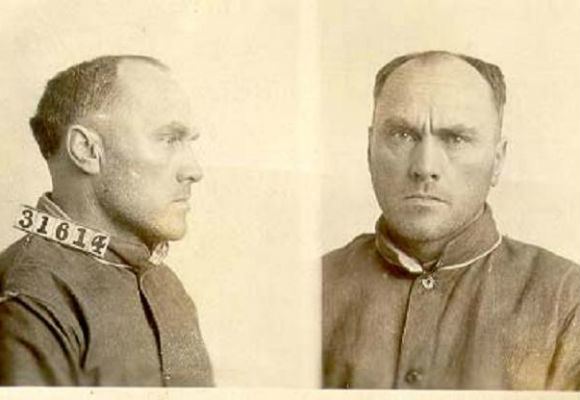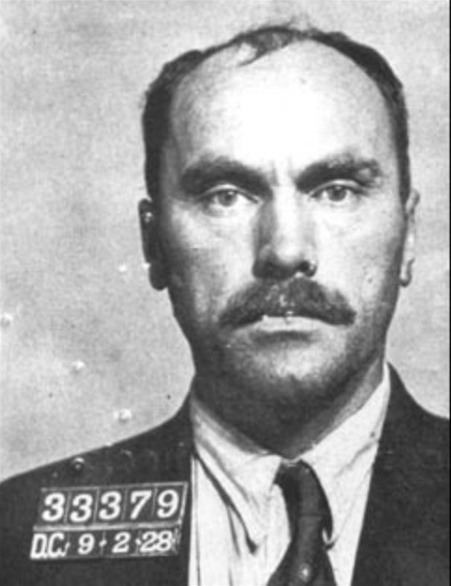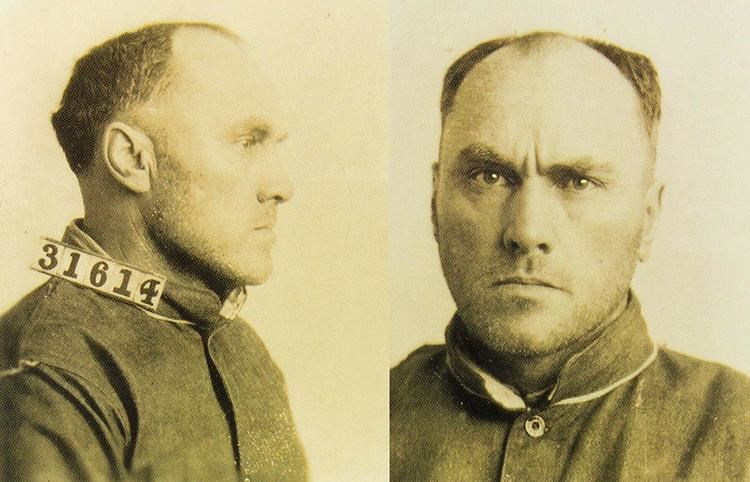Role Serial Killer Name Carl Panzram | Country US, Angola Victims 5–22 | |
 | ||
Other names Carl BaldwinJeff DavisJefferson DavisJefferson RhodesJeff RhodesJack AllenJefferson BaldwinJohn KingJohn O'LearyCooper JohnTeddy Bedard Date apprehended 1928Arrests/prison terms:1903–1905; 1908–1910; 1911; 1913–1915; 1915–1918; 1923; 1923–1928; 1928–1930 Parents Johann Panzram, Matilda Panzram Similar People James French, John Borowski, Albert Fish, Peter Kurten, Ted Bundy | ||
Criminal penalty Death by Hanging | ||
Carl panzram biography
Carl Panzram (June 28, 1891 – September 5, 1930) was a serial killer, rapist, arsonist, and burglar. In jailhouse confessions and his autobiography, he claimed to have committed 21 murders—most of which could not be corroborated—and over 1,000 sodomies of boys and men. After a series of imprisonments and escapes, he was executed in 1930 for the murder of a prison employee at Leavenworth Federal Penitentiary.
Contents
- Carl panzram biography
- Carl panzram wiki videos
- Early life
- Criminal career
- Murder spree
- Imprisonment and confession
- Execution
- Aftermath
- References

Carl panzram wiki videos
Early life

Born in East Grand Forks, Minnesota, the son of East Prussian immigrants Johann "John" and Matilda Panzram, Carl was raised on his family's farm with five siblings. In 1903, at the age of 12, he stole some cake, apples, and a revolver from a neighbor's home. Soon after, his parents sent him to the Minnesota State Training School. While there, he was repeatedly beaten, tortured, and raped by staff members in what attendees dubbed "The Painting House", because children would leave "painted" with bruises and blood. Panzram hated this place of torture so much that he decided to burn it down, and did so without detection.

In late 1905, Panzram was released from the school. By his teens, he was an alcoholic and was repeatedly in trouble with the authorities, often for burglary and theft. He ran away from home at the age of 14. He often traveled via train cars; he later claimed that on one train he was gang raped by a group of hobos.
Criminal career

In 1907, at the age of 15, after getting drunk in a saloon in Montana, Panzram enlisted in the U.S. Army. Shortly thereafter he was convicted of larceny and served a prison sentence from 1908 to 1910 at Fort Leavenworth's United States Disciplinary Barracks. Then-Secretary of War William Howard Taft approved the sentence. Panzram later claimed that any goodness left in him was smashed out during his Leavenworth imprisonment.
After his release and dishonorable discharge, Panzram resumed his career as a thief, stealing anything from bicycles to yachts, and was caught and imprisoned multiple times. He served time under his own name and various aliases in Fresno, California; Rusk, Texas; The Dalles, Oregon; Harrison, Idaho; Butte, Montana; Montana State Reform School in Miles City; Montana State Prison (as "Jeff Davis" and "Jefferson Rhodes"); Oregon State Prison ("Jefferson Baldwin"); Bridgeport, Connecticut ("John O'Leary"); Sing Sing Correctional Facility, New York ("Jeff Baldwin"); Clinton Correctional Facility, New York ("John O'Leary"); and Washington, D.C. While incarcerated, Panzram frequently attacked guards and refused to follow their orders. The guards retaliated, subjecting him to beatings and other punishments.
In his autobiography, Panzram wrote that he was "rage personified" and that he would often rape men whom he had robbed. He was noted for his large stature and great physical strength—due to years of hard labor at Leavenworth and other prisons—which aided him in overpowering most men he encountered. He also engaged in vandalism and arson. By his own admission, one of the few times he did not engage in criminal activities was when he was employed as a strikebreaker against union employees. On one occasion, he tried to sign aboard as a ship's steward on an Army transport vessel, but was discharged when he reported to work intoxicated.
On June 1, 1915, Panzram burglarized a house in Astoria, Oregon, but was arrested soon after while attempting to sell some of the stolen items. He was sentenced to seven years in prison, to be served at the Oregon State Penitentiary in Salem, where he arrived on June 24. Warden Harry Minto believed in harsh treatment of inmates, including beatings and isolation, among other disciplinary measures. Later, Panzram stated that he swore he "would never do that seven years and I defied the warden and all his officers to make me." Later that year, Panzram helped fellow inmate Otto Hooker escape from the prison. While attempting to evade recapture, Hooker killed Minto, marking Panzram's first known involvement in a murder, as an accessory before the fact.
Panzram was disciplined several times while at Salem, including 61 days in solitary confinement, before escaping on September 18, 1917. After two shootouts he was recaptured and returned to the prison. On May 12, 1918, he escaped once again by sawing through the bars of his cell, and caught a freight train heading east. He began going by the name John O’Leary and shaved off his moustache. He would never return to the Northwest.
Murder spree
In August 1920, Panzram burgled the New Haven, Connecticut home of War Secretary Taft, whom he held responsible for his Leavenworth imprisonment. He stole a large amount of jewelry and bonds, as well as Taft's Colt M1911 .45 caliber handgun. He then began a murder spree that spanned eight years and multiple countries. With the money stolen from Taft he bought a yacht, the Akiska. He lured sailors away from New York City bars, got them drunk, raped and shot them with Taft's pistol, then dumped their bodies near Execution Rocks Light in Long Island Sound. He claimed to have killed ten in all.
The sailor murders ended only after the Akiska ran aground and sank near Atlantic City, his last two potential victims escaping to parts unknown. Panzram then caught a ship to Africa and landed in Luanda, Portuguese Angola. He later claimed that while there, he raped and killed an 11- or 12-year-old boy. In his confession to this murder, he wrote: "His brains were coming out of his ears when I left him and he will never be any deader." He also claimed that he hired a boat with six rowers, shot the rowers with a German Luger pistol, and threw their bodies to the crocodiles.
After returning to the U.S., Panzram asserted that he raped and killed two small boys, beating one to death with a rock on July 18, 1922 in Salem, Massachusetts and strangling the other later that year near New Haven. Panzram claimed that, in June 1923, he shot a man with a .38 pistol he had stolen from a yacht which belonged to the police chief of New Rochelle, New York. After his last arrest in 1928, he claimed to have committed a murder while burglarizing homes between Baltimore and Washington, D.C., and two other murders of young boys in Philadelphia in 1923 and 1928.
Panzram later wrote that he had also contemplated mass killings and other acts of mayhem, such as poisoning a city's water supply with arsenic, or scuttling a British warship in New York Harbor to provoke a war between the U.S. and Great Britain.
Imprisonment and confession
In 1928, Panzram was arrested for burglary in Washington. During his interrogation, he voluntarily confessed to killing two boys. In light of his extensive criminal record, he received a 25-years-to-life sentence. Upon arriving at Leavenworth Federal Penitentiary, he warned the warden, "I'll kill the first man that bothers me", and was given a solitary job in the prison laundry room. On June 20, 1929, he beat the laundry foreman to death with an iron bar, and was sentenced to death. He refused to allow any appeals of his sentence. In response to offers from death penalty opponents and human rights activists to intervene, he wrote, "The only thanks you and your kind will ever get from me for your efforts on my behalf is that I wish you all had one neck and that I had my hands on it."
While on death row, Panzram was befriended by a guard named Henry Lesser (1902–1983), who provided him with writing materials. While awaiting execution he wrote a detailed summary of his crimes and nihilistic philosophy. It began with a straightforward statement:
Execution
Panzram was hanged on September 5, 1930. As guards attempted to place a black hood over his head, he allegedly spat in the executioner's face. When asked for any last words, he responded, "Yes, hurry it up, you Hoosier bastard! I could kill a dozen men while you're screwing around!" His grave, at the Leavenworth Penitentiary Cemetery, is marked only with his prison number, 31614.
Aftermath
In 1938, Karl Menninger wrote Man Against Himself, including writing about Panzram using the pen name of "John Smith", with Panzram Prison Number # 31614. Lesser preserved Panzram's letters and autobiographical manuscript, then spent the next four decades in search of a publisher willing to print the material. Finally, in 1970, it was released under the title Killer: A Journal of Murder. In 1996, the book formed the basis of a film of the same name, starring James Woods as Panzram and Robert Sean Leonard as Lesser. In 1980, Lesser donated Panzram's material to San Diego State University, where they are housed, as the "Carl Panzram papers", in the Malcolm A. Love Library. In 2012 filmmaker John Borowski released a documentary entitled Carl Panzram: The Spirit of Hatred and Vengeance.
